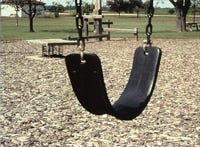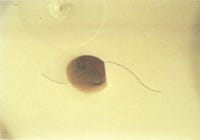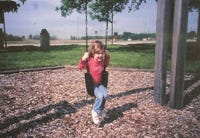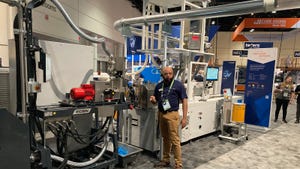By Design: Accidents waiting to happen
In this recurring column, Glenn Beall of Glenn Beall Plastics Ltd. (Libertyville, IL) shares his special perspective on issues important to design engineers and the molding industry.
October 29, 2008
|
IMM's part design expert identifies dangerous potential failures in children's swings.
I started Glenn Beall Engineering Inc. in Gurnee, IL, a little town halfway between Chicago and Milwaukee. At the time I wasn't smart enough to know what a good location Gurnee was. I now realize that if you can't make it in the plastics industry halfway between Chicago and Milwaukee, you are not going to make it anywhere.
Gurnee is about 200 miles from my hometown in midwestern Illinois. I have no idea how many times I have made that drive to visit the family. These trips are normally interrupted once or twice by visits to roadside rest areas. Among other things these rest stops provide an opportunity to stretch one's legs with a short stroll.
Plastic replaces wood and steel
Over the years I have been intrigued by the evolution of playground equipment at these rest areas. It has been interesting to watch the wood and steel equipment replaced by bright-colored plastic structures. The sliver-prone, wood sliding board rails with backside-burning, sun-heated sheet metal bottoms have been replaced by spiral, one-piece, rotationally molded plastic slides.
Playground equipment used to set on lawns with the grass worn away under the swings and the end of sliding boards. These grassy playgrounds have now been replaced by wood-chip-covered soft bases to protect exuberant children who fall.
The ever-popular swing has slowly evolved into a sophisticated product. During my grade school days, swings consisted of a rope and a board with two holes. The ropes have been replaced by chains. In a later development these chains were dip-coated with plastisol. The coating makes it more difficult for children to get their fingers caught in the chain or pinched between two links.
The wooden seats were eventually reinforced with galvanized steel end caps. The end caps increased the useful life of the wooden seats while providing a finished look and reliable attachment points for the chains. Regrettably, the metal end caps became a safety issue.
For as long as there have been swings, people have been struck by free-swinging seats. The end caps increased the weight of a seat. These heavier seats struck with greater force. This normally results in a painful learning experience and a bruise that serves as a reminder to be more careful in the future. In some instances, children were struck in the head or face by a metal end cap. These encounters could result in serious injuries.
Several well-publicized lawsuits prompted school administrators and park managers to demand safer swing seats. The photo above left shows one of the designs that evolved. This molded elastomeric sling-type seat is the subject of this story. Children can still be struck by this seat. There is, however, less chance of injury, as the seat is lighter in weight and the material is relatively soft.
A valuable habit
Early in my career I had the good fortune to work for George Ryan. Mr. Ryan was as much a teacher as a boss. Among other things, he taught his designers to learn by examining as many molded parts as possible. After all these years I am still picking up and studying plastic parts. This habit has provided me with valuable insight on how parts are designed and molded.
It was only natural that I would examine the molded sliding boards and swing seats. The top of the part has a raised pattern to prevent the user from sliding off the seat. The chain attachment holes at each end are reinforced with molded-in metal inserts.
The bottom of the seat, shown in the first photo, has a wide reinforcing band, or rib, all the way around its periphery. This band contains a series of D-shaped blind holes along both sides of the seat.
I examined these parts off and on for a couple of years. I was interested in how well these soft seats withstood the loads at the chain attachment points. The attachment points remained secure. I did, however, notice stress cracks beginning to emanate from the corners on the D-shaped holes. This was no surprise, as I had seen this type of failure on numerous occasions.
For example, the fan hub shown is driven by the flat on the D-shaped mounting hole. Vibration of the fan resulted in a crack at one end of the flat. That crack propagated across the flange and the amplitude of the vibration increased. A second crack then appeared and the fan subsequently exploded. (The cause of the fan's failure is detailed in the June 2001 IMM By Design article, "Hole Configurations," imm.plastics
today.com/?q=articles/9626.)
Round hole advantage
Holes of all shapes can be molded, but round is ideal. The big advantage of a round hole is that it is one continuous radius. There are no interruptions in the radius that can become stress concentrators. Independent of where the hole is loaded, the force is transmitted around the radius to be supported by the maximum amount of plastic material. This combination of factors makes round holes strong. If the continual radius that forms a round hole is interrupted by something like a flat, or a keyway, stresses are concentrated around that irregularity. This is what is happening to the swing seats.
There is no limit to the weight of the people who use these swings. It is common to see adults using swings to recapture pleasant childhood memories. These swing seats are molded flat and then bent into a U shape. This bending creates a tensile load on the bottom side of the seat. The weight of an adult puts an additional stretching load on the material around the D-shaped holes.
There was no indication of ultraviolet light or chemical attack. The most logical cause of these cracks was stretching of the seats and stress concentrations at the ends of the flats on the holes. There is a high probability that round holes would have prevented these cracks.
Accidents waiting to happen
Recent examinations reveal that these cracks have now progressed all the way through the side and are starting across the top of the seat.
The most disturbing part of this story is that we put our most precious things into these swings. People have a right to expect swings in public places to be safe for normal use. I have shown these deteriorating seats to rest-area attendants. They seemed genuinely concerned. They told me the playgrounds were controlled by the state. If replacement seats were not in the budget, nothing would happen this year. They did, however, agree to call this situation to the attention of the responsible person.
My drive home covers only 200 miles of highway. I cannot help but wonder how many more of these seats are in use at rest areas along this country's many highways. If those seats are like the ones I've seen, they represent a lot of accidents getting ready to happen.
About the Author(s)
You May Also Like






